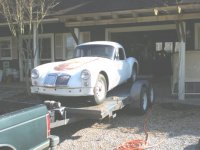vagt6 said:
<snip>
Is your '69 V/8 original (i.e., not a conversion)?
My favorite MG of all, the factory V/8. As soon as I win the lottery, I'm getting a RHD one.
the factory didn't begin production of the V8 until 1973....here's the history (from the MG Enthusiasts BBS):
<span style="font-weight: bold">MGB/GT V8</span>
In 1973, another big engined MGB appeared on the scene, but unlike the MGC, this one was to be extremely well received to the extent that demand far outstripped supply. But in spite of this, this car was also to disappear after a relatively short production run - it was the MGB GT V8.
A former Mini racer turned car tuner named Ken Costello set the scene for what would follow when he uprated an MGB by ditching its heavy iron straight four 'B-Series' engine in favour of the ex-Buick alloy V8 engine which had been adopted by the Rover Car Company. It did not take the engineers at Abingdon long to get wind of Costello's exploits - and indeed no less a person than British Leyland boss Lord Stokes invited Costello to demonstrate his prototype. Within a very short space of time, MG was given the go-ahead to build its own prototype - work on which began in August 1971 - but between then and the launch of the factory MGB GT V8 two years later, Costello was able to do healthy business. Naturally Costello stole a march on British Leyland since he had no corporate "red tape" to deal with - so while MG had to deal with the problems of type approval and other modifications, Costello was able to shoehorn the engine into place on a custom-built basis. When MG launched its own MGB GT V8, the hitherto easy supply of parts essential to Costello's own conversion began to be stemmed, but undaunted, Costello found it cheaper to buy secondhand Buick engines from Belgium, which he brought back by the lorry-load and rebuilt using new Rover parts.
The car made use of the 3532cc aluminium Rover V8 engine as was being used in the Range Rover. Developed from an early Buick design, the engine was very light in weight - it actually weighed less than the original B-series MGB engine - and in standard tune offered a healthy 137bhp. It fitted snugly into the MGB's engine bay after only slight modification to the bulkhead, and with the development of a low-rise exhaust manifold allowed MG to use the standard MGB bonnet. Furthermore, the engine could, unlike in the MGC, be fitted without dispensing with the front suspension crossmember, so the coil-spring type suspension could be retained. The standard suspension was employed at the rear too, but the ride height was increased by an inch all round. The engine was mated to the MGC gearbox and rear-end transmission, although the ratios were slightly modified.
The combination of the Rover V8 engine and the MGB produced an excellent touring car with high performance, good economy, and good handling. The press received it well and it found a ready market, although it was never exported to the USA for some unknown reason.
In 1976, the car was killed off, supposedly because of the limited supply of engines, which were being built under licence and were required for Rover's new SD1 saloon. Another contributing factor to the cars demise was the fuel crisis which was experienced in 1975, which led people to buy smaller engined, more economical cars. Given the obvious success of the car, it seems strange that it was ended, and possibly there was more to it that just these factors. The MGB GT V8 was, after all, in much greater demand than Triumph's V8-engined Stag, which continued in production...

 Hi Guest!
Hi Guest!

 smilie in place of the real @
smilie in place of the real @
 Pretty Please - add it to our Events forum(s) and add to the calendar! >>
Pretty Please - add it to our Events forum(s) and add to the calendar! >> 






